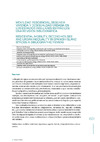Please use this identifier to cite or link to this item:
https://accedacris.ulpgc.es/jspui/handle/10553/114503
| Title: | Movilidad residencial, segunda vivienda y desigualdad urbana en los espacios insulares españoles: una revisión bibliográfica | Other Titles: | Residential mobility, second houses and urban inequality in spanish island spaces: a bibliographic review | Authors: | Lardiés-Bosque, Raúl Domínguez-Mujica, Josefina Parreño-Castellano, Juan Manuel Pérez-González, Jesús M. |
UNESCO Clasification: | 540401 Geografía urbana 520301 Movilidad y migraciones interiores |
Keywords: | Movilidad residencial Migraciones Segunda vivienda Desigualdad urbana Islas españolas, et al |
Issue Date: | 2021 | Publisher: | Asociación Española de Geografía Universidad de La Laguna |
Conference: | XXVII Congreso de la Asociación Española de Geografía | Abstract: | La llegada de migrantes residenciales y el turismo residencial no son fenómenos nuevos, pero han ido ganando importancia en España, y en particular en zonas costeras.
Se trata de un fenómeno de múltiples dimensiones como la migratoria, segundas viviendas, el desarrollo turístico y la urbanización. A su vez, este hecho tiene múltiples
consecuencias socioeconómicas y territoriales, consecuencias que han sido estudiadas por geógrafos y sociólogos, principalmente.
En esta comunicación analizamos la literatura académica sobre este fenómeno
múltiple, con dos objetivos. Por una parte, reconocer las principales publicaciones
existentes y el ámbito territorial al que se refieren y, por otra parte, identificar el contenido temático de esas publicaciones en las zonas costeras de España y, en especial,
en las islas Canarias y Baleares.
Los resultados muestran que estamos ante un fenómeno multidisciplinar y con
distintas dimensiones temáticas (migraciones, urbanización, segunda vivienda,
etc.), y que se ha tratado en la literatura de forma aislada y pocas veces de forma integral. Estudios futuros deberían atender a esa integración de temáticas para responder
cómo la migración ligada al turismo (y las variaciones en su composición y su distribución espacial en zonas residenciales y urbanas) influye o genera desigualdades
territoriales. The arrival of residential migrants and residential tourism are not new phenomena, but they have been gaining importance in Spain, and particularly in coastal areas. It is a phenomenon of multiple dimensions such as immigration, the increment of second homes, tourism development and urbanization. In turn, this phenomenon has multiple socioeconomic and territorial consequences that have been widely analyzed, mainly by geographers and sociologists. This contribution aims to analyze the academic literature on this multiple phenomenon, with two objectives. On the one hand, to recognize the main existing publications and the territorial scope to which they refer. On the other hand, to analyze the thematic content of these publications on this phenomenon in the coastal areas of Spain, and especially on the Canary and Balearic Islands. The results show that we are dealing with a multidisciplinary phenomenon with several thematic dimensions (migration, urbanization, second home, etc.), which have usually been dealt with in the literature in isolation and seldom comprehensively. Future studies should address this double relationship to answer how tourism- related migration (and variations in its composition and spatial distribution in residential and urban areas) influence or generate territorial inequalities. |
URI: | https://accedacris.ulpgc.es/handle/10553/114503 | ISBN: | 978-84-123678-8-1 | DOI: | 10.25145/c.27.Asociacion.Geografia.2021.15 | Source: | Geografía, cambio global y sostenibilidad. Comunicaciones del XXVII Congreso de la Asociación Española de Geografía. Tomo III Territorio, desigualdad y enfermedades, p. 621-635 |
| Appears in Collections: | Actas de congresos |
Page view(s)
272
checked on Nov 1, 2024
Download(s)
173
checked on Nov 1, 2024
Google ScholarTM
Check
Altmetric
Share
Export metadata
Items in accedaCRIS are protected by copyright, with all rights reserved, unless otherwise indicated.
